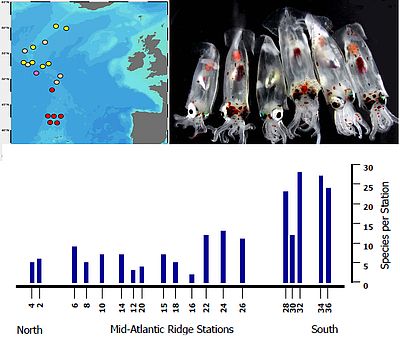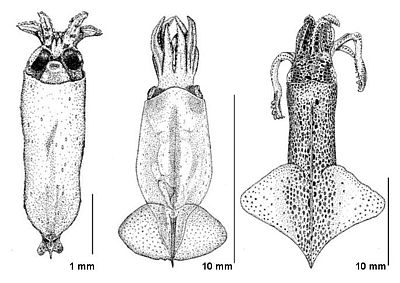Dr. Uwe Piatkowski; ext. 4571
Cephalopod diversity along the Mid-Atlantic Ridge
MAR-ECO (Mid Atlantic Ridge ECOsystems, www.mar-eco.no),a pilot project of the Census of Marine Life (CoML, www.coml.org) had been implemented to study the pelagic ecosystems associated with the Mid-Atlantic Ridge (MAR) from Iceland to the Azores and to understand the structure and function of mid-ocean ridge communities. During several oceanographic expeditions nekton distribution, diversity, and species associations were observed, sampled and mapped along and across the northern MAR.
Besides zooplankton and fish, cephalopods were a major faunal group that characterized the ridge communities. During an oceanographic expedition with the Norwegian RV G.O. Sars in 2004 more than 1,200 specimens belonging to ca. 44 species and 25 families were sampled and identified from net catches ranging down to 3,000 m depth, many of them for the first time in this region (Vecchione et al., 2010a,b). The squid Gonatus steenstrupi, an important prey for marine top predators was the most abundant cephalopod, but some new species could also be described, with the deep-water squid Promachoteuthis sloani being a very prominent form (Young et al., 2006). The cephalopod species diversity increased from north to south. The present study, while extensive, has only been a summer-season snapshot. We have yet to discover the extent of seasonal changes either in species composition or in the occurrence of any species we found at the MAR.

This research has been a major component of the Census of Marine Life initiative (CoML) which has been largely funded by the Alfred P. Sloan Foundation. Further financial support came from national institutions, especially from Norway, and from MarBEF, the Marine Biodiversity and Ecosystem Functioning EU Network of Excellence
Vecchione M, Young RE, Piatkowski U (2010a) Cephalopods of the northern Mid-Atlantic Ridge. Mar Biol Res 6:25-52
Vecchione M, Bergstad OA, Byrkjedal I, Falkenhaug T, Gebruk AV, Godoe OR, Gislason A, Heino M, Hoines AS, Menezes GMM, Piatkowski U, Priede IG, Skov H, Soiland H, Sutton T, de Lange Wenneck T (2010b) Biodiversity patterns and processes on the mid-Atlantic ridge. In: McIntyre AD (ed.) Life in the world's oceans: diversity, distribution and abundance. Wiley-Blackwell, Chicester, UK, pp 103-121
Young RE, Vecchione M, Piatkowski U (2006) Promachoteuthis sloani, a new species of the squid family Promachoteuthidae (Mollusca: Cephalopoda). Proc Biol Soc Washington 119:287-292
Early life stages of cephalopods: taxonomy and distribution
Pelagic regions of the subtropical Atlantic Ocean are often regarded as „deserts“, because they are characterised by low primary productivity and low standing stocks of zooplankton and nekton. However, prominent current systems, seamounts and islands may create productive environments in these areas, in which cephalopods aggregate, feed and recruit.
Their early life stages can occur in exceptionally high densities and their distribution is often closely related to hydrographic conditions. In our ongoing research we examine comprehensive collections of oceanic cephalopods sampled near seamounts, but also in oceanic regions of the subtropical Atlantic Ocean. The epi- and mesopelagic early life cephalopods are a major focus of our studies. We document their distribution patterns, compile identification keys, and illustrate the various early life stages of the cephalopod species.

The drawings above – prepared by Matthias Schneider – illustrate different growth stages of the common clubhook squid Onychoteuthis banksii, a species complex that is very abundant in the subtropical Atlantic Ocean (Diekmann et al., 2002; 2006). They show the significant change of the cephalopod’s body form and size during its ontogeny and demonstrate possible morphological adaptations to different habitats which the animals pass through during their life cycle.
This research is supported by the German Research Council (PI 203/6-1/2), and the Census of Marine Life project.
Diekmann R, Piatkowski U, Schneider M (2002) Early life and juvenile cephalopods around seamounts of the subtropical eastern North Atlantic: Illustrations and a key for their identification. Ber Inst Meereskunde 326:1-42
Diekmann R, Nellen W, Piatkowski U (2006) Multivariate approaches to the variation of larval fish and paralarval cephalopod assemblages at Great Meteor Seamount.
Deep-Sea Res I 53:1635-1657
Glacial squids and shallow water octopods of the Southern Ocean
Considering the influence of environmental change on the Southern Ocean ecosystems and the services they provide, it is crucial to establish comprehensive baseline information on the Antarctic marine biodiversity, as a sound benchmark against which future changes can reliably be assessed (DeBroyer et al., 2011). Cephalopods are one of the most charismatic faunal groups in the Southern Ocean with less than 50 species of squids and octopods (Piatkowski, 2009). Of the ca. 20 squid species which regularly appear south of the Antarctic Polar Front, only two of them are endemic: the Antarctic neo-squid Alluroteuthis antarcticus and the glacial squid Psychroteuthis glacialis; but all of the squids are of pivotal importance in the high-Antarctic food web. Particularly, studies on the ecology and distribution of P. glacialis are of importance in our working group, because this species seems to be the only squid that inhabits the most southern waters like the Weddell Sea where it is supposed to prey on krill and myctophids (lanternfish) and where it forms the major prey of emperor penguins and seals (Piatkowski, 2011).
Information on Antarctic octopod species and their diversity has grown substantially during the last years. We described twelve new octopod species from bottom trawl samples taken during several expeditions with the RV Polarstern in the vicinity of the Antarctic Peninsula (e.g. Allcock et al. 2007; Vecchione et al. 2009a) (see species images below). The samples illustrate a higher than expected octopod species diversity and supply new information on their distribution patterns and ecological aspects. Furthermore, the trawl samples show that octopus populations have gained significantly higher abundances around the Antarctic Peninsula than in areas nearby. We speculate that this elevated abundance occurred after the rapid depletion of demersal fish stocks and may indicate a possible shift in the structure of the ecosystem (Vecchione et al. 2009b).
This research is based on financial support by the German Research Council and on extensive field work during several expeditions to the Southern Ocean. It is performed in close collaboration with the NMFS National Systematics Laboratory, National Museum of Natural History, Smithsonian Institution, Washington DC,USA (Dr. Michael Vecchione), and the Department of Zoology, Ryan Institute, National University of Ireland, Galway (Dr. Louise Allcock), and is supported by the Tree of Life project http://tolweb.org (Dr. Richard Young)
Allcock AL, Strugnell JM, Prodöhl P, Piatkowski U, Vecchione M (2007) A new species of Pareledone (Cephalopoda: Octopodidae) from the Antarctic Peninsula Waters. Polar Biol 30:883-893
DeBroyer C, Danis B, with 64 SCAR-MarBIN Taxonomic Editors (2011) How many species in the Southern Ocean? Towards a dynamic inventory of the Antarctic marine species. Deep-Sea Res II 58:5-17
Piatkowski U (2009) Cephalopod populations in Antarctic waters. In Hempel G, Hempel I (eds) Biological Studies in Polar Oceans. Exploration of Life in Icy Waters. Wirtschaftsverlag NW, Bremerhaven, pp 171-172.
Piatkowski U (2011) Psychroteuthidae Thiele 1920. Psychroteuthis glacialis Thiele 1920. tolweb.org/Psychroteuthis_glacialis/19783/2011.03.20 in The Tree of Life Web Project, tolweb.org
Vecchione M, Allcock L, Piatkowski U, Strugnell, J (2009a) Benthoctopus rigbyae, n.sp., a new species of cephalopod (Octopoda; Incirrata) from near the Antarctic Peninsula. Malacologia 51:13-28
Vecchione M, Allcock L, Piatkowski U, Jorgensen E, Barratt I (2009b) Persistent elevated abundance of octopods in an overfished Antarctic area. In Krupnik I, Lang MA, Miller SE (eds) Smithsonian at the Poles. Contributions to the International Polar Year Science. Smithsonian Institution Scholarly Press, Washington, DC, pp 197-203
back



